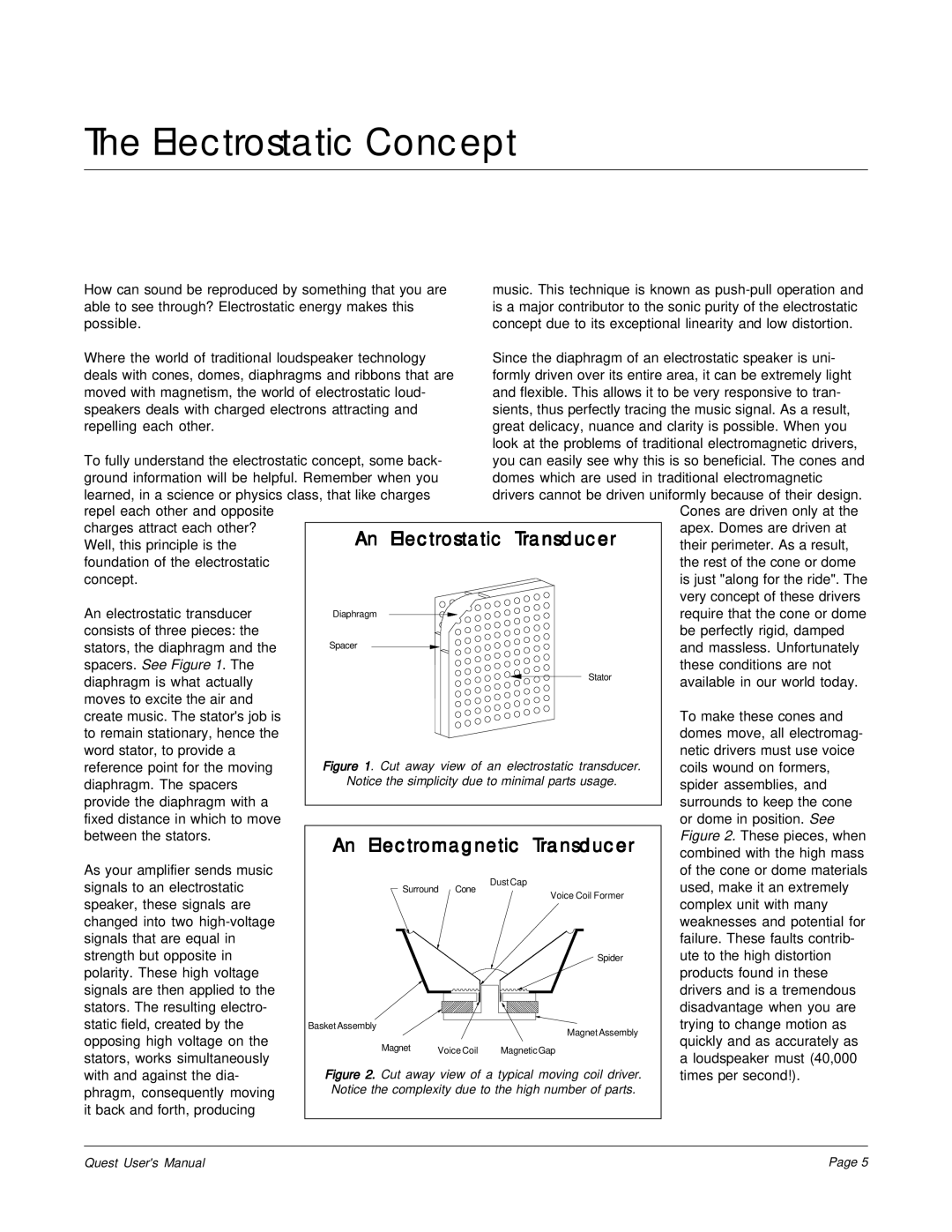
The Electrostatic Concept
How can sound be reproduced by something that you are | music. This technique is known as | ||||
able to see through? Electrostatic energy makes this |
| is a major contributor to the sonic purity of the electrostatic | |||
possible. |
|
| concept due to its exceptional linearity and low distortion. | ||
Where the world of traditional loudspeaker technology |
| Since the diaphragm of an electrostatic speaker is uni- | |||
deals with cones, domes, diaphragms and ribbons that are | formly driven over its entire area, it can be extremely light | ||||
moved with magnetism, the world of electrostatic loud- |
| and flexible. This allows it to be very responsive to tran- | |||
speakers deals with charged electrons attracting and |
| sients, thus perfectly tracing the music signal. As a result, | |||
repelling each other. |
|
| great delicacy, nuance and clarity is possible. When you | ||
To fully understand the electrostatic concept, some back- | look at the problems of traditional electromagnetic drivers, | ||||
you can easily see why this is so beneficial. The cones and | |||||
ground information will be helpful. Remember when you | domes which are used in traditional electromagnetic | ||||
learned, in a science or physics class, that like charges |
| drivers cannot be driven uniformly because of their design. | |||
repel each other and opposite |
|
|
| Cones are driven only at the | |
charges attract each other? | An Electrostatic Transducer | apex. Domes are driven at | |||
Well, this principle is the | their perimeter. As a result, | ||||
foundation of the electrostatic |
|
|
| the rest of the cone or dome | |
concept. |
|
|
| is just "along for the ride". The | |
|
|
|
| very concept of these drivers | |
An electrostatic transducer | Diaphragm |
|
| require that the cone or dome | |
consists of three pieces: the |
|
|
| be perfectly rigid, damped | |
stators, the diaphragm and the | Spacer |
|
| and massless. Unfortunately | |
spacers. See Figure 1. The |
|
| Stator | these conditions are not | |
diaphragm is what actually |
|
| available in our world today. | ||
|
|
| |||
moves to excite the air and |
|
|
|
| |
create music. The stator's job is |
|
|
| To make these cones and | |
to remain stationary, hence the |
|
|
| domes move, all electromag- | |
word stator, to provide a | Figure 1. Cut away view of an electrostatic transducer. | netic drivers must use voice | |||
reference point for the moving | coils wound on formers, | ||||
diaphragm. The spacers | Notice the simplicity due to minimal parts usage. | spider assemblies, and | |||
provide the diaphragm with a |
|
|
| surrounds to keep the cone | |
fixed distance in which to move |
|
|
| or dome in position. See | |
between the stators. | An Electromagnetic Transducer | Figure 2. These pieces, when | |||
| combined with the high mass | ||||
As your amplifier sends music |
|
| Dust Cap | of the cone or dome materials | |
signals to an electrostatic | Surround Cone | used, make it an extremely | |||
Voice Coil Former | |||||
speaker, these signals are |
|
| complex unit with many | ||
|
|
| |||
changed into two |
|
|
| weaknesses and potential for | |
signals that are equal in |
|
|
| failure. These faults contrib- | |
strength but opposite in |
|
| Spider | ute to the high distortion | |
polarity. These high voltage |
|
|
| products found in these | |
signals are then applied to the |
|
|
| drivers and is a tremendous | |
stators. The resulting electro- |
|
|
| disadvantage when you are | |
static field, created by the | Basket Assembly |
| Magnet Assembly | trying to change motion as | |
opposing high voltage on the |
|
| quickly and as accurately as | ||
Magnet | Voice Coil | MagneticGap | |||
stators, works simultaneously | a loudspeaker must (40,000 | ||||
|
|
| |||
with and against the dia- | Figure 2. Cut away view of a typical moving coil driver. | times per second!). | |||
phragm, consequently moving | Notice the complexity due to the high number of parts. |
| |||
it back and forth, producing |
|
|
|
| |
Quest User's Manual | Page 5 |
